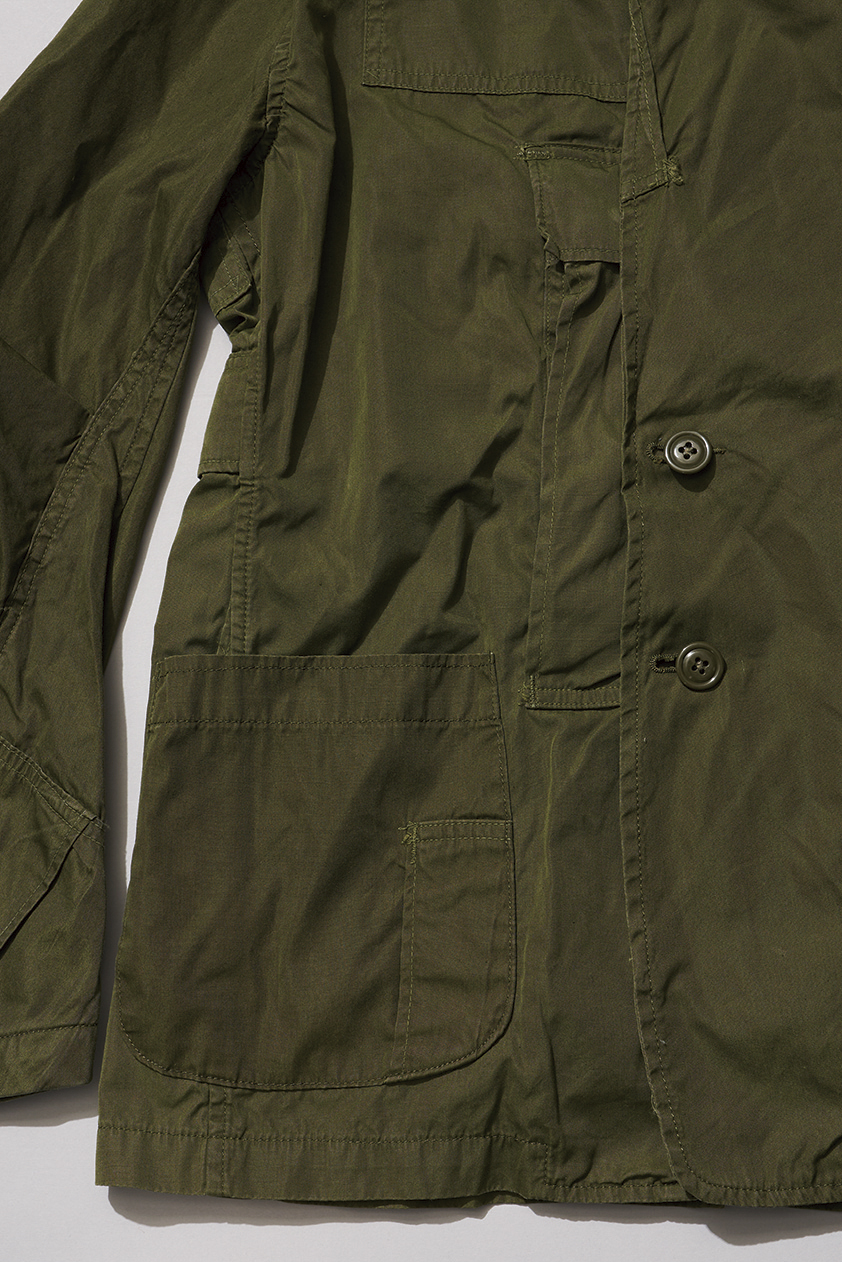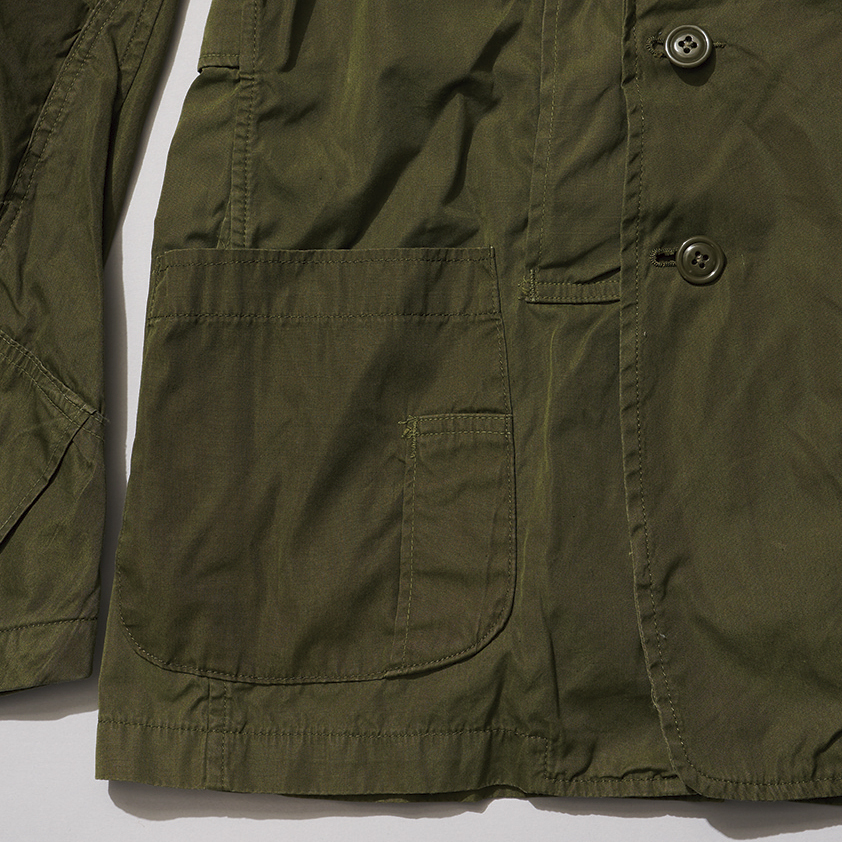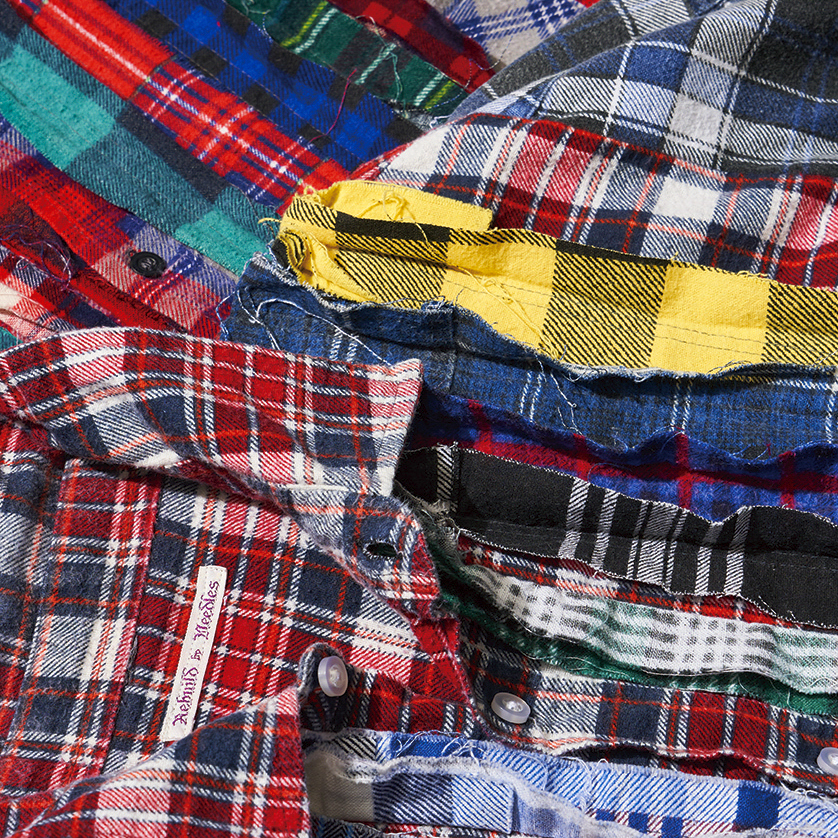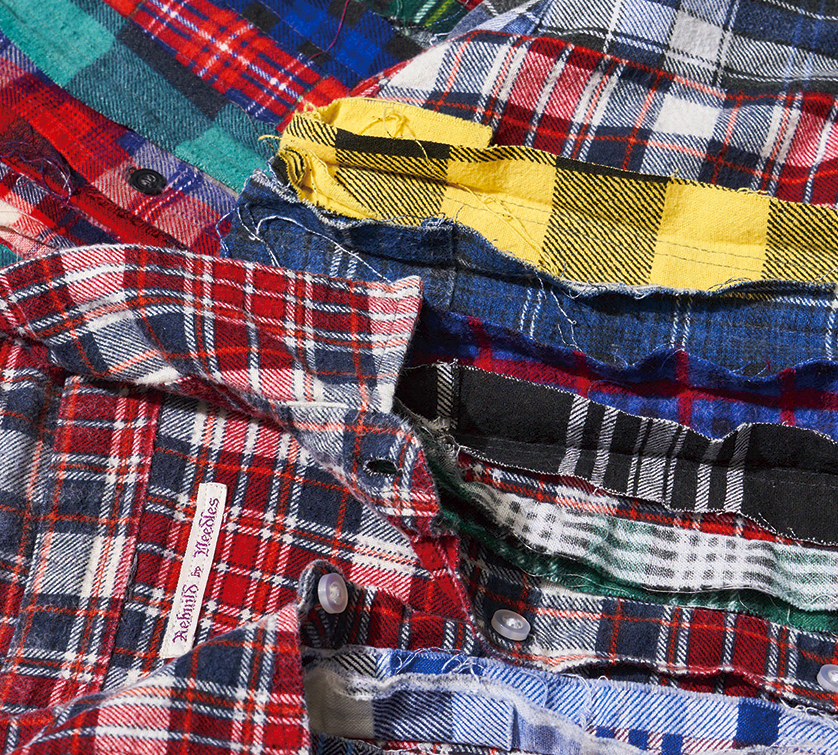古着をもとに新たな服を作る。ただし「リメイク」ではなく、「リビルド」する。このふたつの言葉、似たように聞こえるかもしれないが、あえて「リビルド」と名乗るのには確かな理由がある。それは歴代のアーカイヴを見ても明らか。解体されたオーバーパンツがコートになり、プリントのネルシャツはボディを7つもタテに割かれて継がれている。そのどれもが、ミシンの音が聞こえてきそうなほどの、プロフェッショナルなステッチワークを施したアイテムばかり。
遡ること10年以上前にスタートしたコレクションは、「REBUILD」という1点においてブレることなく、しかし手法やアイデアは自在に変化して、独創的なラインナップとなった。一方で古着を素材にするという特性上、作られる数量は限られ、店頭のみでの販売で、人気を得ても売り切れ御免。コレクションの全貌を一望するのは叶わなかった。そこで今回、改めて光を当てたい。〈 REBUILD by NEEDLES 〉とは何か。アーカイヴを紐解きながら、デザイナーの清水慶三に聞く。
- 「古着を使って新しい服を作る」というコンセプトは、どのように生まれたのですか?
- 2010年に〈 REBUILD by NEEDLES 〉を始める前から、古着のリメイクを少しやったりはしていたんです。もともとのきっかけは、80年代からアメリカに買い付けに行くたびに、山のように安い値段で売られている古着を見たことですね。スリフトショップを覗いたりすると、ワゴンに山積みになって「3着で1.99ドル」なんて感じで売られていました。その中には、個人的にすごく好きな服や生地があったので、いつか何とかしたいなっていうのが、頭の中にずっとあったんですね。
- 「REBUILD」という言葉ともアメリカで出会ったとか。
- そうです。90年代後半だったと思いますが、ワシントン州スポケーンにあった〈 WHITE’S 〉の工場で。そこには修理待ちのブーツがいっぱい置いてあったんですが、修理をしている職工たちを見ると、全部を一度解体するような感じで、ソールを剥がしたり、パーツごとに分解したりしてやってたんです。彼らのユーザーのほとんどは、ロガーなどのプロフェッショナルたちです。たとえブーツがボロボロになったとしても、履き込んで自分の足に合うように育っているから、そのフィットを手放したくないわけです。それを叶えるには、新品を買い直すのではなく、破損した外部だけを新しいものにするしかありません。職工たちは、一足一足に向き合って作業しながら、「これはリペアじゃなくて、リビルドなんだ」って言うんです。再構築するという意味合いがある言葉ですが、すごくいい言葉だなと思いました。
- 清水さんの思い描くコレクションを示す言葉として、ふさわしかったんですね。
- ただのリメイクではないものにするつもりだったので。そもそも価値が高い古着に手を加えて、1点モノみたいにして売るのも違うと思いました。〈 NEEDLES 〉としてやりたかったのは、日本でもアメリカでさえも見過ごされて、大量に残っているような古着を使って、新たな価値を持った服を作ること。プロフェッショナルなミシンや技術を使い、アトリエ的なリメイクの手法とは違った、量産できる服を作ること。それを表現する言葉がまさしく、「REBUILD」に思えたんです。
- 見過ごされていた服に、清水さんなりの光を当てるような作業というか。
- そうです。そこで一番最初に作ったのは、ミリタリーのオーバーパンツ( US ARMY M-51 Arctic Over Pant )を使ったコレクションでした。個人的にあのコットンナイロンの生地の風合いがすごく好きだったので。今でこそあの太さもアリになっていますが、当時のシルエットから考えれば太すぎたんですね。だからどの古着屋に行っても、誰も手をつけないようなアイテムとして残っていて、値段もすごく安かったし、倉庫に大量に余っていたんです。


- 素材はパンツだったのに、コートやジャケットになっているのが驚きでした。
- サルエルのようなパンツやスカートも作りましたが、シルエットの問題があったので、パンツとは別のものを作る必要がありました。解体して効率よくフラットにして縫い合わせて、そこに作りたい服のパターンにあてこんでいくようにしたんです。ステッチを外すようなことをすると、手間もかかるし価格も上がってしまうので、あえてやらないようにしました。
- だからひとつずつ、表情やポケットの名残の位置が異なっていたんですね。
- 斜めにステッチが入ったり、ボタンやポケットの位置がありえない場所についていたり。素材を生かしてそれがユニークな個性になる部分は極力そのまま生かしました。もちろん最初の頃は、工場にその感覚を伝えるのがすごく大変でした。ただ、慣れてくると、逆にこちらが驚くような面白い仕上がりになることも。〈 REBUILD 〉に関しては、そこまで制約をつけずに、最低限のルールだけを設けて、その範囲の中で作ってもらうという方法にしています。これは今もそうですね。
好きな古着はまだまだある。
進化は止まらない。
かくしてスタートを切った〈REBUILD by NEEDLES〉。プリント・フランネルを使ったシャツや、Tシャツ、スウェットなど、世界的に定番的な人気を集めるシリーズも生まれ、ツイードジャケットやライダースなど展開はますます多彩に。尽きることのないアイデアとクリエイティビティ。それはもちろん古着への深い理解と愛情が熱源になっている。
- プリント・フランネルを使ったシャツのシリーズは、世界的な人気になりました。
- アメカジが流行った頃のネルシャツはアメリカ製で、チェック柄の厚手のウーブンのものがほとんどでしたが、アメリカでは70年代になると、ワーカーの日常着として国外で大量に安く作るようになり、プリントになっていったんですね。ニール・ヤングなども好んでプリントを着てたと思いますが、自分も昔からそっちの方がカッコイイなって思っていて、プリントのネルシャツばかり着ていました。着てるとけっこうテレテレになるんですが、むしろその雰囲気が好きで。ただ古着だと、縮んじゃったりして、サイズが小さいものが多かったんですよね。
- あのパーツを横に繋げるデザインは、サイズの問題を解消する手段でもあったんですか?
- そうです。そのままでは小さかったので、幅を出したいというのがありました。もとのシャツの形をそのまま生かして3つや7つに切り分けて、それらを入れ替えたのちに再度縫製しています。切り替えによって丈がまちまちなのも、もとのシャツのレングスを生かしているから。必然的に起きてしまう違いも含めてデザインになっています。フランネルシャツに関して言うと、切り替えの部分も含めて、無駄になる部分が一切ないですね。

- まるで腕のいい料理人ですね。
- ははは。頭から尻尾までね。(笑)
- サステナビリティの文脈においても、すごく価値のあることですよね。
- うーん。結果としてそうなっているというのはありますが、それが目的かというと、そうじゃないですね。エコのためにいいからって、無理して作るのも違うと思うし、それを強調するのも好きじゃない。〈 REBUILD 〉としてやりたいのは、個人的に好きだけど、理由があって着にくかったり、余ってしまっている古着を、もう一回、多くの人に着てもらえるようにすること。だからできる限り値段も抑えたいし、ある程度、量産ができるようにしたいんです。
- 見過ごされている古着から、新しい価値を見出すということでしょうか。そのためには、愛すべきポイントを見つける目がまずは必要なのかもしれません。
- そうですね。それがなければ、きっとアイデアも生まれません。数年前から古着も集まりにくくなっていますが、妥協せず好きな古着だけを使いたい。作りたいアイデアはほかにもありますが、それだけの量が揃うかどうかもわからない。その時に整った条件の中で、〈 NEEDLES 〉らしくできることを考えていきたいですね。
What Keizo Shimizu does for REBUILD by NEEDLES is to create new clothes from thrifted outfits. He calls it not remaking but rebuilding. Though these two words have similar meanings, there are sufficient reasons for him to use the word ‘rebuild’ in his collection’s name. You can find them in a series of clothes he has created so far. Just have a look at a coat made out of unstitched over pants or a printed flannel shirt with the body vertically patchworked with seven different pieces. Each item in the collection is precisely elaborated with professional sewing skills.
Although the techniques and ideas he adopts underwent some changes, Shimizu has always stuck to the concept of ‘rebuilding’ since he started this unique collection 10 years ago. However, the amount of clothes he can produce is very much limited because every single piece is made out of thrifted clothes, while all the items in the collection are available only at NEPENTHES stores and won’t be in stock again once they are sold out. It is impossible to gather all the pieces he has rebuilt in one place. But that is actually why we try to shed light on the collection this time. What is REBUILD by NEEDLES? Find out the answer from this interview with designer Keizo Shimizu.
- Where did you get the idea of ‘making new clothes out of thrifted outfits’?
- Even before the launch of REBUILD by NEEDLES in 2010, I sometimes remodeled thrifted clothes. I started it after seeing piles of cheap secondhand clothes at shops in the U.S. It actually happened whenever I had traveled to the country as a buyer since the 1980s. As I visited a thrift shop, there was a wagon full of such clothes with a sign saying like “3 for $1.99”. But I sometimes found my favorite products and fabrics in bargain piles, so I had always wanted to do something with them.
- I’ve heard that you first came to know about the word ‘rebuild’ also in the U.S.
- Yes. I think it was in the late 1990s when I visited WHITE’S factory in Spokane, Washington. They got so many boots to be repaired there and I found out the craftsmen took each of them apart before repairing it, like peeling the soles off and disassembling the parts. Because most of the company’s customers are professionals such as loggers, a pair of good old boots that perfectly fit their feet is utterly essential for their work even if it gets totally worn out. To keep the fit, they would rather let their boots get repaired to replace the damaged surface than to buy a new pair. While busy working on each boot with great care, the craftsmen said to me; “We don’t repair boots. We rebuild them”. It’s really a nice word, I think.
- And you thought the word matches the concept of a collection you envisioned.
- I wanted to make my collection not just a series of remodeled clothes. It should also be different from making a one-of-a-kind product out of valuable vintage clothes. What I wanted to do as NEEDLES was to create clothes with new value from a huge amount of thrifted outfits abandoned in Japan and even in the U.S. Unlike neat products made at a designer’s atelier, my items should be available in volume quantities and made with professional sewing machines and skills. And I thought if I pick a word to describe such a collection, it would definitely be ‘rebuild’.
- Is it like casting a spotlight on leftover clothes in your own way?
- Exactly. So, I created my very first collection with military over pants (US ARMY M-51 Arctic Over Pant) because I personally like the texture of the cotton nylon fabric so much. Such wide leg pants are currently in fashion, but they were too wide at that time. That is why we could find many of them at shops back then. They were sold cheap and stored in warehouse as leftover stock.

- It was amazing to see that you made a coats and jackets from pants.
- I also made sarouel-like pants and skirts, but faced silhouette problems, so I needed to make something different from the pants. Each pair of the over pants should be efficiently taken apart, flattened, and then sewn together to be cut into a pattern of an item I wanted to make. I avoided unstitching as it’s time-consuming and could affect the price.
- Ah that’s why each item comes with a unique appearance and has sewing marks on different places.
- Some of them feature diagonal seams, while others have buttons and pockets on weird places. If there were any characteristic features on the thrifted clothes, I tried to make the best use of them. At the beginning, it was really hard to explain my idea to the factory I use, of course. But, as they got used to it, the result sometimes turns out to be quite unique and surprising to me. I’ve always let them exercise their creativity with bare minimum rules as far as for REBUILD clothes. It’s never changed.
There are more to make.
The collection will continue to evolve.
After the launch, REBUILD by NEEDLES has created a diverse range of items, including tweed jackets and riders. Some of the products - tees, sweatshirts, and shirts made from printed flannels - gained worldwide popularity, becoming the collection’s signature items. Shimizu is never out of ideas and creativity, fueled by his knowledge and love of thrifted clothes.
- A series of the items you made with printed flannel shirts received global popularity.
- Around when the American casual style was a fad in Japan, most of flannel shirts were made in the U.S. with thick woven fabric and designed in plaid. But, in the 1970s, those shirts began to be cheaply mass-produced overseas as everyday clothes for American workers. And they started to print the pattern. I think Neil Young liked to wear printed ones, and I did the same. I thought it looked cooler. Though the fabric gets shabby as you wear it, I rather like it. But thrifted ones are often too small because they got shrunk after use.
- You arranged the material parts horizontally. Is this because the original shirts were small in size?
- Yes, they were too small to use in the original size. And I wanted to broaden the width. So, I cut the flannel shirt into three or seven pieces, while maintaining the original form. Those pieces were then rearranged and sewn together again. There are gaps between the length of the hems because each flannel shirt has its own hem length and I keep it. Such inevitable differences are also part of our design. As for the flannel shirts in the collection, nothing is wasted to make them.


- You are like a skillful cook.
- Haha yeah, using ingredients without waste.
- That’s significant also in terms of sustainability.
- Umm. It happened to be so eventually, but I actually don’t mean it. I think it’s not something we force ourselves to do for the environment, and I don’t like to emphasize it, too. What I’d like to do through REBUILD is to make my favorite thrifted clothes that were hard to wear or abandoned for some reason wearable again. Therefore the price has to be as affordable as possible and the quantity has to be large enough for broad distribution.
- Does it mean you add new value to abandoned thrifted clothes? To do so, a keen insight to find out charms of those items should be necessary above all else.
- I think so. You may not be able to get an idea without it. Though it has been difficult to stock thrifted clothes in the last couple of years, I want to use only my favorite types of clothes as materials for the collection. I won’t settle for less. There are more ideas in my head although we never know if we can have enough thrifted clothes to realize them. As NEEDLES, we just do our best according to the situation we face.